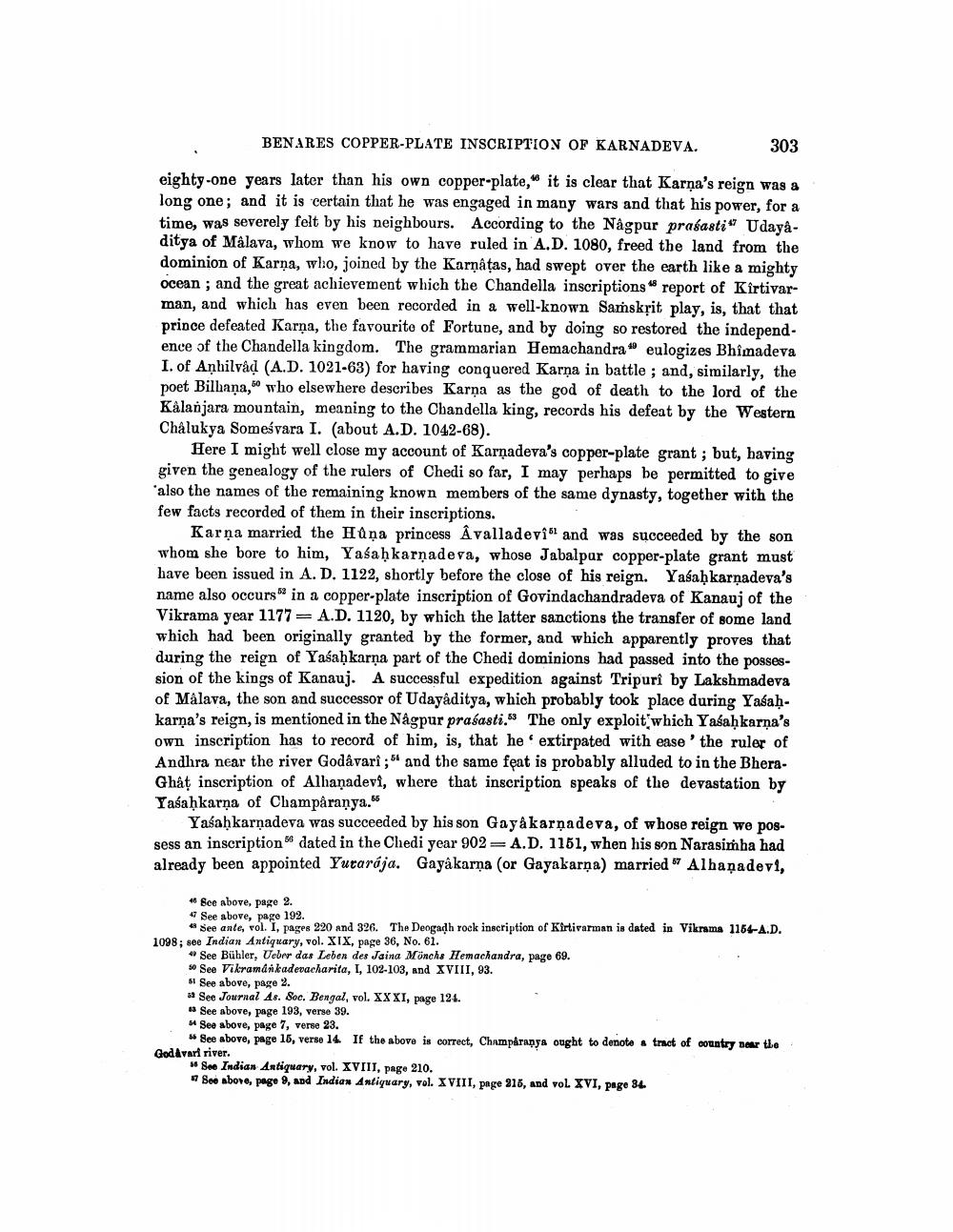________________
BENARES COPPER-PLATE INSCRIPTION OF KARNADEVA.
303
eighty-one years later than his own copper-plate," it is clear that Karna's reign was a long one; and it is certain that he was engaged in many wars and that his power, for a time, was severely felt by his neighbours. According to the Nagpur prasasti" Udayâditya of Mâlava, whom we know to have ruled in A.D. 1080, freed the land from the dominion of Karna, who, joined by the Karnâțas, had swept over the earth like a mighty ocean; and the great achievement which the Chandella inscriptions report of Kirtivarman, and which has even been recorded in a well-known Samskrit play, is, that that prince defeated Karna, the favourite of Fortune, and by doing so restored the independence of the Chandella kingdom. The grammarian Hemachandra eulogizes Bhimadeva I. of Anhilvåd (A.D. 1021-63) for having conquered Karna in battle; and, similarly, the poet Bilhana, who elsewhere describes Karna as the god of death to the lord of the Kalanjara mountain, meaning to the Chandella king, records his defeat by the Western Chalukya Someśvara I. (about A.D. 1042-68).
Here I might well close my account of Karnadeva's copper-plate grant; but, having given the genealogy of the rulers of Chedi so far, I may perhaps be permitted to give also the names of the remaining known members of the same dynasty, together with the few facts recorded of them in their inscriptions.
Karna married the Hûna princess Avalladevi" and was succeeded by the son whom she bore to him, Yaśaḥkarnadeva, whose Jabalpur copper-plate grant must have been issued in A. D. 1122, shortly before the close of his reign. Yasaḥkarnadeva's name also occurs in a copper-plate inscription of Govindachandradeva of Kanauj of the Vikrama year 1177 A.D. 1120, by which the latter sanctions the transfer of some land which had been originally granted by the former, and which apparently proves that during the reign of Yaśaḥkarna part of the Chedi dominions had passed into the possession of the kings of Kanauj. A successful expedition against Tripurî by Lakshmadeva of Målava, the son and successor of Udayâditya, which probably took place during Yaśaḥkarna's reign, is mentioned in the Nagpur prasasti." The only exploit,which Yalah karna's own inscription has to record of him, is, that he extirpated with ease' the ruler of Andhra near the river Godâvarî;" and the same feat is probably alluded to in the BheraGhât inscription of Alhanadevi, where that inscription speaks of the devastation by Yasahkarns of Champaranya."
Yaśaḥkarnadeva was succeeded by his son Gayåkarnadeva, of whose reign we possess an inscription dated in the Chedi year 902 A.D. 1151, when his son Narasimha had already been appointed Yurarája. Gayakarna (or Gayakarna) married" Albapadevi,
46 See above, page 2.
47 See above, page 192.
See ante, vol. I, pages 220 and 326. The Deogadh rock inscription of Kirtivarman is dated in Vikrama 1164-A.D. 1098; see Indian Antiquary, vol. XIX, page 36, No. 61.
See Bühler, Ueber das Leben des Jaina Mönchs Hemachandra, page 69.
so See Vikramankadevacharita, I, 102-103, and XVIII, 93.
51 See above, page 2.
See Journal As. Soc. Bengal, vol. XXXI, page 124.
13 See above, page 193, verse 39.
See above, page 7, verse 23.
ss See above, page 15, verse 14. If the above is correct, Champaranya ought to denote a tract of country near the Godavari river.
56 See Indian Antiquary, vol. XVIII, page 210.
See above, page 9, and Indian Antiquary, vol. XVIII, page 215, and vol. XVI, page 34.




